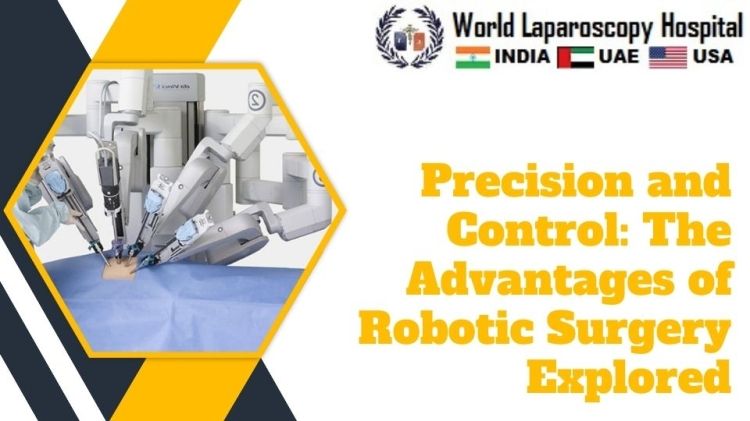Precision and Control: The Advantages of Robotic Surgery Explored
Introduction
In the realm of modern medicine, the integration of technology has continually propelled advancements, and one notable innovation that stands out is robotic surgery. With its promise of enhanced precision and control, robotic surgery has transformed the landscape of medical procedures, offering benefits that extend beyond traditional surgical methods. This article delves into the intricate world of robotic surgery, exploring its advantages, applications, and the profound impact it has on patient outcomes.

The Evolution of Robotic Surgery
Historical Perspective
Robotic surgery finds its roots in the development of telemanipulators in the 20th century, initially designed for military and aerospace purposes. However, it wasn't until the late 20th century that the medical field adopted robotic technology for surgical applications. The da Vinci Surgical System, introduced in the early 2000s, marked a significant milestone, paving the way for the integration of robotics into various surgical specialties.
Technological Components
Understanding the functioning of robotic surgery requires a grasp of its technological components. The da Vinci system, for instance, consists of a console where the surgeon sits, a patient-side cart equipped with robotic arms controlled by the surgeon, and robotic instruments that mimic the surgeon's hand movements with exceptional precision.
Advantages of Robotic Surgery
Precision and Accuracy
One of the primary advantages of robotic surgery is the unparalleled precision it offers. The robotic arms can perform intricate maneuvers with a range of motion beyond the human hand, allowing for delicate procedures in confined spaces. High-definition 3D imaging provides the surgeon with a detailed view, further enhancing accuracy.
Minimally Invasive Procedures
Robotic surgery enables minimally invasive procedures, reducing the need for large incisions. Smaller incisions lead to decreased blood loss, lower risk of infection, and faster recovery times for patients. The ability to navigate through tight spaces with precision makes robotic surgery especially advantageous in areas where traditional methods may be challenging.
Enhanced Ergonomics for Surgeons
The ergonomic design of the robotic console contributes to surgeon comfort during prolonged procedures. The system allows for a natural hand-eye coordination, minimizing fatigue and improving overall control. Surgeons can perform complex surgeries with greater ease, translating to improved outcomes for patients.
Remote Surgery and Telemedicine
Advancements in robotic surgery have paved the way for remote surgeries, where a surgeon can operate on a patient located miles away. This opens up possibilities for telemedicine, enabling access to specialized surgical expertise in remote or underserved areas. The integration of 5G technology further enhances the feasibility of such remote procedures.
Applications Across Specialties
Urology
Robotic surgery has become a cornerstone in urological procedures, including prostatectomies and kidney surgeries. The precision of the robotic system is particularly beneficial in preserving delicate structures, reducing postoperative complications and improving functional outcomes.
Gynecology
In gynecology, robotic surgery has revolutionized procedures such as hysterectomies and myomectomies. The minimally invasive nature of robotic surgery in gynecological procedures results in less scarring, reduced pain, and quicker recovery for patients.
General Surgery
Across various general surgery procedures, such as colorectal surgeries and hernia repairs, robotic systems offer a level of precision that is challenging to achieve with traditional methods. Surgeons can navigate complex anatomical structures with greater ease, leading to improved patient outcomes.
Cardiothoracic Surgery
The field of cardiothoracic surgery has witnessed significant advancements with the incorporation of robotics. Procedures like mitral valve repairs and coronary artery bypass grafting can be performed with enhanced precision, reducing the risk of complications and speeding up recovery.
Challenges and Considerations
Cost Implications
While the benefits of robotic surgery are undeniable, the initial costs associated with acquiring and maintaining robotic systems can be substantial. Hospitals and healthcare providers face the challenge of balancing the upfront investment with the long-term advantages, often leading to careful consideration before adopting robotic technology.
Training and Learning Curve
The proficiency required to operate robotic systems demands specialized training for surgeons. The learning curve can be steep, and institutions need to invest in comprehensive training programs to ensure the safe and effective use of robotic technology. Ongoing education is essential to keep surgeons abreast of technological advancements.
Ethical and Legal Considerations
The integration of robotics in surgery raises ethical and legal questions, particularly concerning issues such as liability in the event of system malfunctions or errors. Clear guidelines and ethical frameworks must be established to address these concerns and ensure patient safety.
Future Directions and Innovations
Artificial Intelligence Integration
The future of robotic surgery lies in the integration of artificial intelligence (AI). AI algorithms can enhance decision-making during surgery, offering real-time insights and predictive analytics. This synergy between robotics and AI holds the potential to further improve surgical outcomes and patient safety.
Miniaturization and Nanorobotics
Advancements in miniaturization and nanorobotics present opportunities for even more minimally invasive procedures. These tiny robotic systems could navigate through the bloodstream to target specific areas, revolutionizing treatments for conditions ranging from cancer to cardiovascular diseases.
Haptic Feedback Technology
Improvements in haptic feedback technology aim to provide surgeons with a sense of touch during robotic procedures. The incorporation of tactile feedback could further bridge the gap between traditional open surgery and robotic-assisted surgery, enhancing the surgeon's ability to perceive tissue characteristics.
Conclusion
Robotic surgery has undeniably transformed the field of medicine, offering unprecedented precision and control in various surgical specialties. As technology continues to advance, the potential for further innovations and applications in robotic surgery is immense. While challenges such as cost and training persist, the benefits in terms of patient outcomes and the evolution of surgical techniques make robotic surgery a promising frontier in modern healthcare. As we navigate the future, the collaboration between technology and surgical expertise is poised to redefine the boundaries of what is possible in the operating room.
